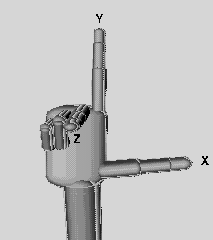X3D graphics principles: Difference between revisions
mNo edit summary |
|||
| Line 8: | Line 8: | ||
== Representation of an object == | == Representation of an object == | ||
This is (roughly) how | This is (roughly) how a 3D object is "built": | ||
#In 3D Graphics, an object is first defined by its edges (points) in a three dimensional x-y-z space. | #In 3D Graphics, an object is first defined by its edges (points) in a three dimensional x-y-z space. | ||
#When those points a are linked together by lines we get a ''wireframe'' rendering of an object. | #When those points a are linked together by lines we get a ''wireframe'' rendering of an object. | ||
#After the frame has been created, a ''surface'' or skin is applied to the object. The surface can have many qualities: color, texture, shininess, reflectivity, etc. | #After the frame has been created, a ''surface'' or skin is applied to the object. The surface can have many qualities: color, texture, shininess, reflectivity, etc. | ||
#Finally, objects are either lit or emit light. Most objects have been lit by a light source and must be shaded. Shading is the most computer intensive task. | #Finally, objects are either lit or emit light. Most objects have been lit by a light source and must be shaded. Shading is the most computer intensive task. | ||
All surfaces can be represented as a set of polygons (that are perfectly flat). Complex Polygons are always split up into triangles by the rendering machine. | All surfaces can be represented as a set of polygons (that are perfectly flat). Complex Polygons are always split up into triangles by the rendering machine. | ||
Polygons have only '''one''' | Polygons have only '''one''' side, the so-called "normal" or outside. Therefore, in X3D even flat objects (such as a sheet of paper) are always represented (as very flat) cubes. For example, a cube is composed of 12 polygons (2 triangles for each side) with their "normals" outside. | ||
== Position and orientation == | == Position and orientation == | ||
Revision as of 17:07, 3 September 2010
Introduction
Principles underlying X3D graphics are similar to other 3D graphic formats and APIs. In this small tutorials we attempt to provide a simplified view useful to beginners.
Representation of an object
This is (roughly) how a 3D object is "built":
- In 3D Graphics, an object is first defined by its edges (points) in a three dimensional x-y-z space.
- When those points a are linked together by lines we get a wireframe rendering of an object.
- After the frame has been created, a surface or skin is applied to the object. The surface can have many qualities: color, texture, shininess, reflectivity, etc.
- Finally, objects are either lit or emit light. Most objects have been lit by a light source and must be shaded. Shading is the most computer intensive task.
All surfaces can be represented as a set of polygons (that are perfectly flat). Complex Polygons are always split up into triangles by the rendering machine.
Polygons have only one side, the so-called "normal" or outside. Therefore, in X3D even flat objects (such as a sheet of paper) are always represented (as very flat) cubes. For example, a cube is composed of 12 polygons (2 triangles for each side) with their "normals" outside.
Position and orientation
The coordinate system
- Width (x axis) or left(-) / right(+)
- Height (y axis) or down(-) / up(+)
- Depth (z axis) or far(-) / close (+)
You can picture the coordinate system with the "right hand rule": "x" is your thumb, "y" the index finger, and "z" the middle finger.
In the picture below, the same principle is illustrated with a snapshot of an X3D scene. The blue ball is in the middle (i.e. coordinates x=0, y=0, z=0) and the viewer is positioned a bit to the right and up and looking a bit to the left.
Other graphics frameworks (e.g. Blender) position these coordinates differently, but an object can be rotated into the same position. Depending on how you hold your hand - fingers always stay stable - you will get a differently oriented coordinate system. To understand the difference between X3D and Blender. Imagine looking into the screen for X3D (so Z is out/in, i.e. "depth"), imagine looking down at a table for Blender (so Z is up/down, i.e. "altitude"). As a general rule it seems that CAD systems use up/down and 3D modelers either up/down or in/out (to be confirmed!)
Yet other systems use a left-hand rule. Read more about the right-hand rule in Wikipedia.
Rotation
Each object can be rotated around the x, y, or z axis (or two or three of them together). The sense of the rotation is also explained with a right hand rule.
Imagine to graph an arrow representing an axis and turn in the direction of the closing hand (curled fingers)


